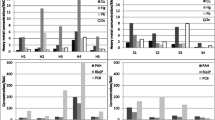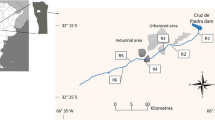Abstract
This paper reports a study of the occurrence and levels of polycyclic aromatic hydrocarbons (PAHs) in a bay characterised by a chronic persistent impact. A total of 55 sediment samples were taken at different depths up to 111 m in two sampling campaigns. Chemical analyses were carried out by gas chromatography-mass spectroscopy. The results indicate that: (1) significant spatial variations exist, (2) levels of PAHs are related more strongly to the spatial distribution of sediments than to mineralogy/granulometry, (3) the sediments are slightly-to-moderately contaminated by PAHs, and (4) these PAHs derive from pyrolytic and petrogenic sources. Through use of an innovative data classification system (proposed according to depth and spatial location of sampling points), and using factorial and cluster techniques, five zones have been differentiated depending on the contamination level and source.



Similar content being viewed by others
References
Anyakora C., Ogbeche A., Palmer P., Coker H. 2005. Determination of polynuclear aromatic hydrocarbons in marine samples of Siokolo Fishing Settlement. Journal of Chromatography A, Volume 1073, Issues 1–2, 6, 323–330
AAPA. 2007. World Port Ranking. American Association of Port Authorities. http://www.aapa-ports.org
APBA. 2008. Autoridad Portuaria de la Bahía de Algeciras http://www.apba.es
Baumard, P., H. Budzinski, P. Garrigues, J.F. Narbonne, T. Burgeot, X. Michel, and J. Bellocq. 1999. Polycyclic aromatic hydrocarbon (PAH) burden of mussels (Mytilus sp.) in different marine environments in relation with sediment PAH contamination, and bioavailability. Marine Environmental Research 47(5): 415–439.
Brown J.N. and B.M. Peake. 2006. Sources of heavy metals and polycyclic aromatic hydrocarbons in urban stormwater runoff. Science of the Total Environment 359: 145–155
Chiou, C.T., S.E. McGroddi, and D.E. Kile. 1998. Partition characteristics of polycyclic aromatic hydrocarbons on soils and sediments. Environmental Science & Technology 32: 264–269.
Code of Federal Regulation. 1982. Title 40, Appendix A to part 423–126 Priority pollutants. 47 FR 52304.
Council Directive 96/62/EC. 1996. On ambient air quality assessment and management. Official Journal of the European Union L296, 21/11/1996, p. 0055–0063.
Council Directive 2008/105/EC. 2008. On environmental quality standards in the field of water policy, amending and subsequently repealing Council Directives 82/176/EEC, 83/513/EEC, 84/156/EEC, 84/491/EEC, 86/280/EEC and amending Directive 2000/60/EC of the European Parliament and of the Council. Official Journal of the European Union L348, 21/11/1996, p. 0084–0097.
De Luca, G., A. Furesi, R. Leardi, G. Micera, A. Panzanelli, P.C. Piu, and G. Sanna. 2004. Polycyclic Aromatic Hydrocarbons Assessment in the Sediments of the Porto Torres Harbor (Northern Sardinia, Italy). Marine Chemistry 86: 15–32.
Djomo, J.E., P. Garrigues, and J.F. Narbonne. 1996. Uptake and Depuration of Polycyclic Aromatic Hydrocarbons From Sediment by the Zebrafish (Bracydanio rerio). Environmental Toxicology and Chemistry 15: 1177–1181.
Folk, R.L., and W.C. Ward. 1957. Brazos River Bar a Study in the Significance of Grain Size Parameters. Journal of Sedimentary Petrology 27: 3–26.
García-Robledo, E., A. Corzo, J. García de Lomas, and S.A. van Bergeijk. 2008. Biogeochemical Effects of Macroalgal Decomposition on Intertidal Microbenthos: a Microcosm Experiment. Marine Ecology Progress Series 356: 139–151.
Ghosh, U., J.S. Gillette, R.G. Luthy, and R.N. Zare. 2000. Microscale Location, Characterization, and Association of Polycyclic Aromatic Hydrocarbons on Harbor Sediment Particles. Environmental Science Technologies 34: 1729–1736.
Giacalone, A., A. Gianguzza, M.R. Mannino, S. Orecchio, and D. Piazzese. 2004. Polycyclic Aromatic Hydrocarbons in Sediments of Marine Coastal Lagoons, in Messina, Italy: Extraction and GC/MS Analysis, Distribution and Sources. Polycyclic Aromatic Compounds 24: 153–149.
IARC. 1983. Monographs on the evaluation of the carcinogenic risk of chemical to humans polycyclic aromatic compounds, Part I chemical, environmental and environmental data. International Agency for Research in Cancer, Lyon, 32
Jiang, B., H. Zheng, G. Huang, H. Ding, X. Li, H. Suo, and R. Li. 2007. Characterization and Distribution of Polycyclic Aromatic Hydrocarbon in Sediments of Haihe River, Tianjin China. Journal of Environmental Sciences 19: 306–311.
La Rocca, C., L. Conti, R. Crebelli, B. Crochi, N. Iacovella, F. Rodriguez, L. Turrio-Baldassarri, and A. di Domenico. 1996. PAH Content and Mutagenicity of Marine Sediments from the Venice Lagoon. Ecotoxicology and Environmental Safety 33(3): 236–245.
Macías-Zamora, J.V., E. Mendoza-Vega, and J.A. Villaescusa-Celaya. 2002. PAHs Composition of Surface Marine Sediments: a Comparison to Potential Local Sources in Todos Santos Bay, B.C., Mexico. Chemosphere 46(3): 459–468.
Martínez-Lladó, X., O. Gibert, V. Martí, S. Díez, J. Romo, J.M. Bayona, and J. de Pablo. 2007. Distribution of Polycyclic Aromatic Hydrocarbons (PAHs) and Tributyltin (TBT) in Barcelona Harbour Sediments and their Impact on Benthic Communities. Environmental Pollution 149: 104–113.
Massart D.L. and Kaufman L. 1983. Interpretation of analytical chemical data by the use of cluster analysis. Chemical analysis, v. 65. Wiley, New York. ISBN: 0-471-07861-1
Mastral, A.M., and M.S. Callen. 2000. A Review on Polycyclic Aromatic Hydrocarbon (PAH) Emissions from Energy Generation. Environmental Science & Technology 34(15): 3051–3057.
McCready, S., D.J. Slee, G.F. Birch, and S.E. Taylor. 2000. The Distribution of Polycyclic Aromatic Hydrocarbons in Surficial Sediments of Sydney Harbour, Australia. Marine Pollution Bulletin 40(11): 999–1006.
McElroy, A. E., Farrington, J. W. and Teal, J. M. 1989. Bioavailability of polycyclic aromatic hydrocarbons in the aquatic environment. Ed. U. Vanarasi. CRC, Boca Raton, FL. 1–40
Morales-Caselles, C., J. Kalman, I. Riba, and T.A. DelValls. 2007. Comparing Sediment Quality in Spanish Littoral Areas Affected by Acute (Prestige, 2002) and Chronic (Bay of Algeciras) Oil Spills. Environmental Pollution 146: 233–240.
Neff, J.M. 1979. Polycyclic aromatic Hydrocarbons in the Aquatic Environment, Sources, Fates, and Biological Effects. London: Applied Science.
NOAA 1999. Sediment Quality Guidelines developed for the National Status and Trends Program, National Oceanic and Atmospheric Administration, United States.
Porte, C., and J. Albaigés. 1993. Bioaccumulation Patterns of Hydrocarbons and Polychlorinated Biphenyls in Bivalves, Crustaceans and Fishes. Archives of Environmental Contamination and Toxicology 26: 273–281
Soclo H. H., Garrigues Ph., and Ewald M. 2000. Origin of Polycyclic Aromatic Hydrocarbons (PAHs) in Coastal Marine Sediments: Case Studies in Cotonou (Benin) and Aquitaine (France) Areas. Marine Pollution Bulletin, Volume 40, Issue 5, 1. 387–396
Tweede Kamer, T. 1994. Evaluatienota Water. Dutch standards for contaminated sediments 21 250, 27–28. 21 (250)
USEPA 1996. Method 3540 C: Soxhlet extraction. United States Environmental Protection Agency. www.epa.gov
USEPA. 2000. Method 3620 C: Florisil cleanup. United States Environmental Protection Agency. www.epa.gov
Viguri, J.R., M.J. Irabien, I. Yusta, J. Soto, J. Gómez, P. Rodriguez, M. Martinez-Madrid, J.A. Irabien, and A. Coz. 2007. Physico-Chemical and Toxicological Characterization of the Historic Estuarine Sediments. A Multidisciplinary Approach. Environment International 33: 436–444
Wentworth, C.K. 1922. A Scale of Grade and Class Terms for Clastic Sediments. Journal of Geology 30: 377–392
Acknowledgements
The work described was supported partly by the projects OT 2006/048 and P06-FQM-02075 financed by the Regional Government, Junta de Andalucia (Spain). E.R.-N. thanks the Obra Social la Caixa for funding her master’s grant, and she thanks the Ministry of Science and Innovation for funding her research fellowship (FPU). We are grateful for the collaboration of the doctors Giuseppe Cultrone and Daniel Gonzalez-Fernandez. We would like to thank the University Cadiz School of Modern Languages (CSLM) and Mrs Denise Hughes for English correction.
Author information
Authors and Affiliations
Corresponding author
Rights and permissions
About this article
Cite this article
Rojo-Nieto, E., Garrido-Pérez, C., Anfuso-Melfi, G. et al. The Zoning of Semi-Enclosed Bodies of Water According to the Sediment Pollution: The Bay of Algeciras as a Case Example. Estuaries and Coasts 34, 1129–1139 (2011). https://doi.org/10.1007/s12237-011-9389-3
Received:
Revised:
Accepted:
Published:
Issue Date:
DOI: https://doi.org/10.1007/s12237-011-9389-3




